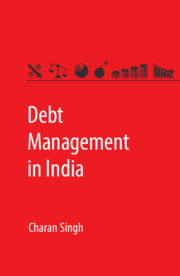Book contents
- Frontmatter
- Contents
- List of Tables and Figures
- Preface
- 1 Introduction
- 2 Public Debt in India
- 3 Ricardian Equivalence: Introduction
- 4 Ricardian Equivalence: Empirical Studies Utilising Consumption Function
- 5 Ricardian Equivalence and Consumption in India
- 6 Monetisation of Debt in India
- 7 Domestic Debt and Economic Growth in India
- 8 Separation of Debt from Monetary Management
- 9 Conclusions and Policy Implications
- Bibliography
- Index
2 - Public Debt in India
Published online by Cambridge University Press: 23 November 2018
- Frontmatter
- Contents
- List of Tables and Figures
- Preface
- 1 Introduction
- 2 Public Debt in India
- 3 Ricardian Equivalence: Introduction
- 4 Ricardian Equivalence: Empirical Studies Utilising Consumption Function
- 5 Ricardian Equivalence and Consumption in India
- 6 Monetisation of Debt in India
- 7 Domestic Debt and Economic Growth in India
- 8 Separation of Debt from Monetary Management
- 9 Conclusions and Policy Implications
- Bibliography
- Index
Summary
In India, domestic debt has been rising at a higher rate than the national income since 1952. The rise in domestic debt has been a result of large domestic borrowings resorted to by the government to achieve a higher rate of economic development. Therefore, the pattern, trend and the components of domestic debt need to be analysed. In this chapter, a discussion on the domestic debt of the government in India is presented.
In India, domestic debt of the central and the state governments are separately published and analysed. But in order to analyse the impact of domestic debt on macro aggregates in the economy, it is important to have a consolidated debt position of the government. Therefore, in this chapter, a consolidated position of the debt situation of the government, both the central and the states, is computed and presented.
Trends in the domestic debt of India
India's public debt, as a percentage of GDP, steadily increased between 1952 and 1990 and then after some respite started rising again from 1999–2000 to reach a peak by 2003–04 (Table 2.1).
The pattern in the rise of public debt reveals that external debt rose rapidly until 1971, with a quantum increase in 1966–67 and since then has been taken over by domestic debt. The trend in annual growth rates of domestic and external debt, and GDP are presented in Figure 2.1. External debt increased by an annual average rate of 23.7 per cent from 1952 to 1980 while domestic debt increased by 10.1 per cent. In the period 1980–81 to 1990–91, both external and internal increased by nearly 19.2 per cent. Since 1991–92, the rate of annual increase of domestic debt is higher than external debt.
The rise in public debt is mainly due to the domestic debt. India's domestic debt has been steadily increasing since 1952.2 The domestic debt rose from 31.0 billion in 1952 to 89.1 trillion by end March 2016, an annual average growth of 13.27 per cent during the period. The domestic debt as a per cent of GDP rose from 32.7 per cent in 1952 to 76.8 per cent in 31 March2004 and since then has declined to reach 65.6 per cent in March 2016 (Table 2.1).
- Type
- Chapter
- Information
- Debt Management in India , pp. 8 - 61Publisher: Cambridge University PressPrint publication year: 2018



